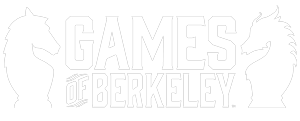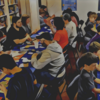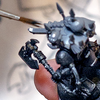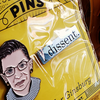Happy Anniversary, Games of Berkeley
Donald Reents founded Games of Berkeley. Later he went on to co-found Gamescape, and purchase and operate Berkeley Game Distributors before selling it all, moving to Fort Wayne, Indiana and starting a little company called Chessex (one of the largest and most respected roleplaying dice companies in the world), which he still runs to this day. Here he reminisces a bit about the early days on Games of Berkeley's actual 40th Anniversary.

40 years. Wow! Who knew that the store would last this long. At the same time, it does not seem so long ago when the store was first opened on June 5th, 1980. Even though I started and ran the store for only 5 years, there are so many memories. I appreciate all of the people I worked with when I owned the store and all of the subsequent owners for keeping the store going all of these years. Obviously, I also appreciate all of the customers over the years who allowed the store to prosper and continue all of these years. Obviously, I wish all the best for the store, staff, and customers and that it will continue for at least another 40 years!
For those of you who are not daunted by a lot of rambling text, I have written about some of my history and experiences with the store throughout the years that I owned it. There are so many more than just these but it would take days to write everything down and nearly as much time to read them.
Working at The Gambit on Telegraph in 1979 and early 1980
The Gambit was a retail game store with two locations when I started and eventually three locations, 2 in SF and the one in Berkeley. I got a job there as a clerk as I knew some of the owners through their sponsorship of backgammon tournaments at Day's in SF. In looking back, this store had an amazing amount of talent in the owners and the workers. Almost everyone I knew who worked there had good careers in anything they did after they left the store. Charlie Crank left The Gambit to go work at Chaosium and that opened a position for which I was hired. Rory Root, later the founder of Comic Relief, was the manager of the store. I worked there for 6 months when we were told the owners were not going to renew the lease in Berkeley and they would shut down the store at the end of the year, about 8 months later and we should look for other work. Since I felt the closing of the store was partially due to personal conflicts between the owners and that the business model was doable, I decided to leave the store and open my own store in Berkeley. At the time, I was concerned that the owners of The Gambit (Bob and Celeste Hamilton, Gary and Tita Grady, and Mark Okada) would feel like I was betraying them for going in competition with them. However, the owners later told me that they did not have a problem with this at all as it was they who told me that I would be out of a job soon. They also said that they figured someone would open a game store in Berkeley and they were happy it was someone they knew. We later did some combination purchases together. Those were good times as the adventure or hobby game field was completely new to me as I was more of a backgammon and chess player. It was very interesting discovering all of these games and I thought they were very good and worthwhile to promote. Essentially, at The Gambit, I found something that I felt was worthwhile doing.
Trying to find a location for the store was not easy. Many realtors did not want to talk to a 24-year-old with very little financial backing and no business experience about renting a retail space. One asked me directly if a person could make money only selling games. Some will say that this is debatable even today. :-) To his credit, he would stop in from time to time to tell me how impressed he was and to congratulate me on making the store work. I have to thank Frank Chen, the building owner, who rented the space to me simply on a handshake, first and last month's rent and a security deposit. If it wasn't for him, the store may never have happened.
Doing everything possible to save money was always the mantra of the store. As the saying goes, $10 is not a lot of money...until you don't have it. At he start, I definitely did not have it to spare.
Cleaning the original store at 2110 Addison Street to get ready for Games of Berkeley. The former tenant was a restaurant and I don't think the ceiling, walls, or floor had been cleaned in years. The walls went from a dark to a light beige. The floor had carpet squares put down and the foam and adhesives had disintegrated. The floor needed to be re-carpeted but there was little money for that. I took a look at the dilapidated carpet squares and noticed that there was a tile floor underneath and after checking a few areas, the tile floor looked to be in reasonable condition. So the decision was made to try cleaning off the carpet squares and seeing how the tile looked. It was a difficult job to scrap all of the adhesive form the tiles but after many days and nights we got enough of it off so that the tile looked OK.
Fixtures were needed. With little money, I improvised. Many of the initial fixtures were improvised or scavenged. Rasputin Records was throwing out some record racks. They worked well for RPG books and jigsaw puzzles. I was able to buy some old glass display cases from Hink's and Mr. Mopps (since 1962 on MLK & Rose) for very little cost. I took a door I found in the trash, used some thin pallet frames also found in some trash, wire, and a tablecloth and turned it into a display table. My brother made some shelves that may still be in use today.
We developed a system for displaying miniatures in the used U-shaped display case that incorporate the floor tiles that we had pulled up from the floor. Nothing was wasted at that time as we had very little money.
Then I took whatever money I had left and bought inventory. My starting inventory value was $12,000. It was critical that I had a good idea of what sold from my experiences at The Gambit. That really helped me avoid wasting money on games that were not likely to sell. At that time, every dollar counted. When I had it all in the store, which was a total of 900 square feet including the office and bathroom, I started to put out the fixtures and inventory. I soon discovered that I could not fill up the store with either inventory or fixtures. So, I reduced the size of the store to around 550 square feet (15' x 35') and then I would have enough fixtures to fill the store area and if I put all the product facing flat, they would cover all the shelves and other displays. A bed sheet cover was the back "wall" of the store.
The night before or the previous night, I can't remember now, I had a huge anxiety attack. The thought suddenly occurred to me, "What happens if no one shows up and buys anything?" I guess that sometimes it is better to just go out and do something and not think of any of the consequences of things going wrong. As the old saying goes, "Fortune favors the brave." I figured that it was too late to stop now so its best not to lose any sleep over it. However, for that night, that was easier said than done. Sometimes you just have to have confidence in yourself and if you make a mistake, have confidence that you will learn from that mistake and be better for it...and hope that any one or series of mistakes isn't enough to make you fail.
At the time, I figured out that the store had to be somewhat profitable within 3 months or it would go out of business. That is not a long time for any new business to get to profitability. What helped me was that I was willing to work long hours, did not have many personal expenses, and I had friends who could help work in the store who I could trust. Chris Lawson, John Fuller, and Richard Dost really helped out during this early period.
As it turned out, I had planned on going to a family reunion over 4th of July weekend back in March before all of this happened. I decided to go and leave the store to the staff. I remember calling back at the end of Saturday and everyone was pretty excited as we had a really good day, a bit more than double of any day previously. It was at that point that I thought that the store was going to make it as our gross profit margin was more than our overhead for the first week ever. If this could be done after only 5 weeks, then I felt the store was on a good trajectory sales-wise.
What helped was the staff of The Gambit would send people to Games of Berkeley if they did not have the game they were looking for in stock. This was very nice of them.
There were so many breaks that the store received. That first year was the year the Rubik's Cube was first introduced. David Singmaster, who later wrote a book on the Cube, gave a seminar on how the Cube relates to group theory in mathematics at UCB. This was in August before the craze hit. I sold many cubes to people who were at the seminar and I knew at that time that it was going to be a hit. I stocked up as much as I could. During December, I sold them all and the Rubik's Cube was 40% of my sales from the date of opening. That is a huge percentage for a $14 item. Also, we had it in stock until December 24th when everyone else was sold out. It was in high demand. A lady in SF send her chauffeur over to the store to get 3 for her relatives. I thought it was really amusing to have a Rolls Royce pull up in front of this funky shop to buy something. What this did was "put us on the map" as people would seek us out to buy one where they normally would never know we existed. This extra advertising may, in the long run, have been more important that the profit from the sales of the Cube during this period.
When the year ended, The Gambit closed in Berkeley. The owners offered me any of the fixtures they were not going to use in their SF locations. Again, this was very nice of them. It was also very helpful to me as by that time, I was thinking of expanding out the store to include some or all of the space that was behind the bed sheets.
The next year we sold a lot of Rubik's Cubes. We also sold a lot of everything else. All the profits went back into inventory. We had the fortune of seemingly have a hit game every year for awhile. There was a game called Kensington that was not a good game but it had great marketing. There was Trivial Pursuit. There was Pictionary. All these things helped tremendously. I could say at this point...and the rest is history.
Along the way, there were many amusing and interesting events. There were a fair share of disappointments and problems, too. Overall, though, I look back and remember them fondly even though it was a lot of 100+ hour work weeks. I liked the building aspect of the business so it really felt more like a hobby than a job. If it was a job, there is no way I could have worked that many hours and kept my interest. Some of them were:
I bought some playing cards that a company was closing out because they were from a German company whose abbreviation was "ASS" and that was on each of the cards. For some reason, they did not sell well in the mass market. :-) They were good quality and they sold well.
One year, I made a big purchase of jigsaw puzzles and the company, based in NY, had a special that if you bought so much, you would get free freight. Since freight on jigsaw puzzles and be 15%-20% of the cost of the puzzle, I decided to make this minimum for free freight. When the 100 or so big boxes showed up, there was no place to put them. I eventually found space for them all in storage but it took a week. All that time there were cartons of jigsaw puzzles on the floor in the aisles.
It was always interesting to have conversations with the customers. Bob Corbett and Tom (I can't remember his last name) would always be a good conversation about historical simulation games. Then there was Jigsaw Joe. He loved jigsaw puzzles and he donated some to go on our wall for display. I remember one day when a boy, about 11, walked up with copies of Cross of Iron, Crescendo of Doom, and G.I. Anvil of Victory. I had to ask him if he knew what he was buying as they are all supplements of Squad Leader and are a pretty high-level rules-heavy game and fairly expensive. He said he did and paid for them. I think the games may have come close to outweighing him.
At one point, we ran out of space at the Addison Street location but I wanted to show people the size of jigsaw puzzles based on their number of pieces. Also, I wanted to display some craps and roulette felts. The only place left was the ceiling. It wasn't easy attaching the wood-backed jigsaw puzzle to the ceiling as we had to crawl through the small space in the rafters between the drop ceiling and the actual ceiling and hope that we would not be too heavy and we'd come crashing down.
In 1984, we moved from Addison to Shattuck Avenue as we had completely run out of space. The new location was more than double the space. We started the actual move of the store on a Friday at closing time and worked through the night to be able to open the next morning. We already had some "new" fixtures to spread out a lot of the inventory that was crammed in at the old location. With the help of the staff, which included Michael Sloan as well as Brian Collins and friends of my brother's, we were able to open at 10AM the next morning. It wasn't that well organized and there were a lot of details to still get done, but we were functional. I do remember at about 1PM, a lady walked in, looked around and asked how long we had been there. She was a bit surprised when we said 3 hours on Shattuck but 4 years on Addison. She was from Berkeley but never knew of us on Addison. Location can be important for a retail store. Michael and his wife, Janet Winter, later bought the store and ran it until selling it to Janet's son, Erik Bigglestone, who is the current owner.
We had other interesting people walk into the store to look around. The previous tenant on Shattuck was an adult "theater" and that is probably why I could afford the place. There was a certain stigma attached to the building that many prospective tenants did not want to have to contend. We could often tell when a customer of the previous establishment walked in as they often had a surprised look on their face.
Once we had everything organized on the sales floor, I looked around and thought to myself, we have just gone from 800 square feet of store floor on Addison to 1800 square feet at the new place on Shattuck. Where has all the extra space we would finally have gone? The store was still packed with product. Many jigsaw puzzles still had to be displayed on their side rather than their front. It was that incredibly packed in at Addison Street.
Along the way, there were mistakes made and lessons learned. Luckily, none were too big that the store could not recover from over time. What I came to realize, though, is that you learn more from your mistakes than your successes. So when a mistake happens, be flexible in your thinking, recognize the error, earn from it, move on and don't make the same mistake a second time. Mistakes and failures are all part of the journey of learning.
There were many people who worked at the store and helped to make it a success. Really, too many to remember. I mentioned some but there was also Kurt Hassel, Larry Anderson, Pat, Mark Alvarez, Bob Hamm, and he list goes on and on. I want to thank them all.


 Events / Open Gaming / Gift Cards
Events / Open Gaming / Gift Cards
 Activities
Activities
 Games
Games
 Hobby
Hobby
 Novelty
Novelty
 Puzzles
Puzzles
 Toys
Toys
 New Items, Staff Picks, Deals, & Gift Cards
New Items, Staff Picks, Deals, & Gift Cards
 Services
Services
 GoBSmacked!
GoBSmacked!







